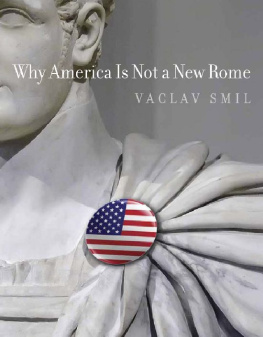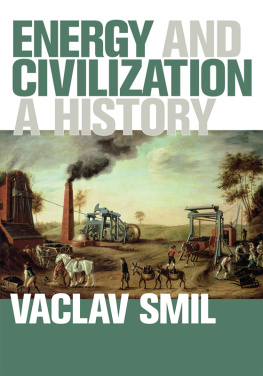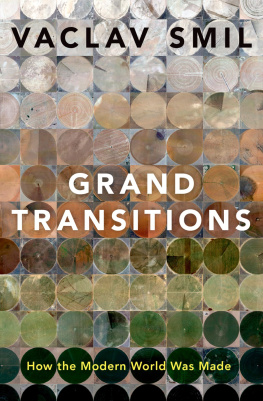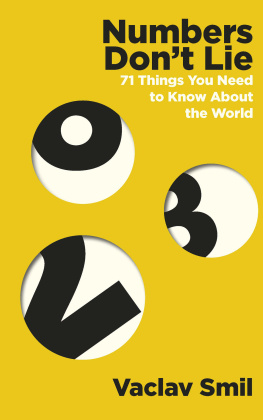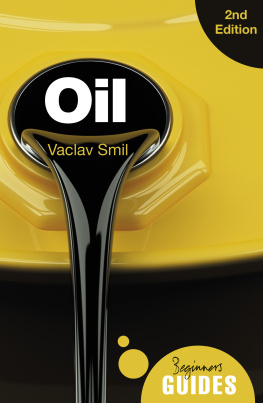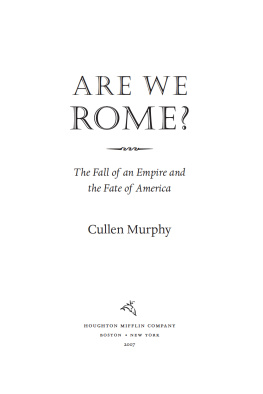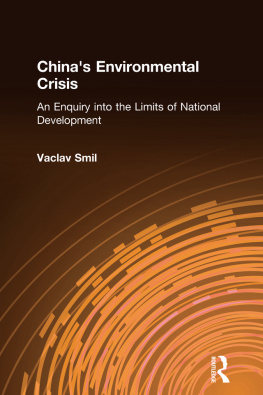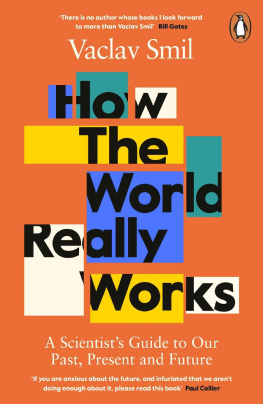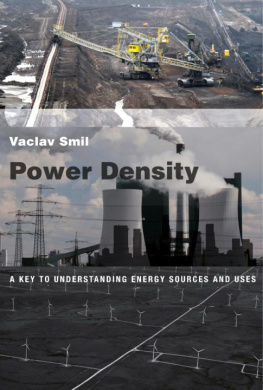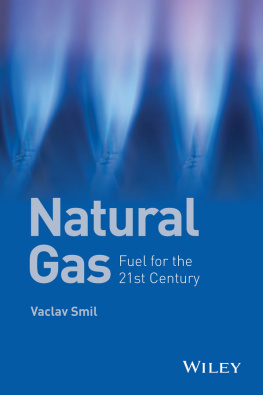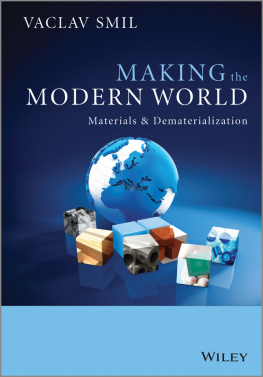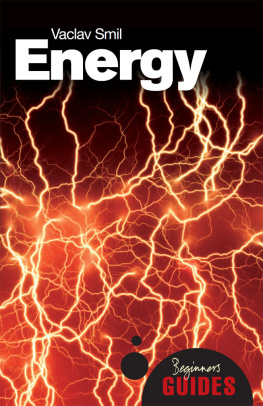
Why America Is Not a New Rome
Also by Vaclav Smil
Chinas Energy
Energy in the Developing World (editor, with W. E. Knowland)
Energy Analysis in Agriculture (with P. Nachman and T. V. Long II)
Biomass Energies
The Bad Earth
Carbon Nitrogen Sulfur
Energy, Food, Environment
Energy in Chinas Modernization
General Energetics
Chinas Environmental Crisis
Global Ecology
Energy in World History
Cycles of Life
Energies
Feeding the World
Enriching the Earth
The Earths Biosphere
Energy at the Crossroads
Creating the 20th Century
Transforming the 20th Century
Energy: A Beginners Guide
Energy in Nature and Society
Oil: A Beginners Guide
Global Catastrophes and Trends
Why America Is Not a New Rome
Vaclav Smil
The MIT Press
Cambridge, Massachusetts
London, England
2010 Massachusetts Institute of Technology
All rights reserved. No part of this book may be reproduced in any form by any electronic or mechanical means (including photocopying, recording, or information storage and retrieval) without permission in writing from the publisher.
For information about special quantity discounts, please email
This book was set in Sabon by SNP Best-set Typesetter Ltd., Hong Kong.
Printed and bound in the United States of America.
Library of Congress Cataloging-in-Publication Data
Smil, Vaclav.
Why America is not a new Rome / Vaclav Smil.
p. cm.
Includes bibliographical references and index.
ISBN 978-0-262-19593-5 (hardcover : alk. paper)
1. United StatesCivilization. 2. United StatesForeign relations. 3. United States Economic conditions. 4. United StatesSocial conditions. 5. Power (Social sciences) United States. 6. RomeHistoryEmpire, 30 B.C.-476 A.D. 7. Power (Social sciences)Rome. 8. World politics21st century. 9. Comparative civilization. I.Title.
E169.1.S5948 2010
973dc22
2009019763
10 9 8 7 6 5 4 3 2 1
Hoc genus in rebus firmandumst multa prius quam
ipsius rei rationem reddere possis...
In matters of this sort full many a truth
Must needs be firmly established ere thou come
To spell the secret of the thing itself...
Lucretius, De rerum natura VI
(Charles E. Bennett translation)
Contents
Preface
Part 1 America as a New Rome?
INihil Novi Sub Sole
Exempla Trahunt
Imperium Americanum
Intentio Libri
Part 2 Why America Is Not a New Rome
II Empires, Powers, Limits
What Is an Empire?
Roman Reach: Hyperboles and Realities
Americas Peculiar Hegemony
IIIKnowledge, Machines, Energy
Inventing New Worlds
Power of Machines
Energy Sources
IV Life, Death, Wealth
Population Dynamics
Illness and Death
Wealth and Misery
VHistorical Analogies and Their (Lack of) Meaning
Common Shortcomings
Fundamental Differences
One World
Notes
References
Name Index
Subject Index
Preface
Comparisons of the Roman Empire, the most powerful state of classical antiquity, and the United States, the most powerful republic of the modern world, have been around for long time, but in a muted, off-center way. Soviet propagandists and European leftists used such comparisons (focused on expansion and far-flung empire building) for decades, but only a combination of events and trends that were too unexpected to be anticipated (and too strange to be invented) made the notion almost commonplace. The key event was the sudden (and amazingly nonviolent) demise of the Soviet empire before the end of 1991. The key trend, preceded by Americas speedy and decisive victory in the Gulf War, was also unexpected: after the hardships of the 1980s America enjoyed vigorous economic growth during most of the 1990s, the shift powered primarily by the diffusion of microchip-based manufacturing, commerce, communication, and personal computing.
As a result, the worlds richest large economy reached a seemingly unchallengeable position of strategic superiority and unprecedented level of average affluence. But these admirable achievements had their obverse in rising trade deficits, growing private indebtedness, retreat of manufacturing, and excessive consumption; and these trends were accompanied by ubiquitous gambling, endless spectacles of televised violent sports (including extremely popular displays of fake, but nonetheless brutal, wrestling), drug addiction affecting millions, and the inescapable presence of celebrity worship. No wonder that many commentators saw in these displays clear parallels with the excesses and vices of ancient Rome.
But then the years of Americas vigorous economic growth and irrational expectations (published books expected that the Dow Jones index would reach not just 40,000 but even 100,000) was ended abruptly with the deflation of the aptly named dot-com bubble in 2000 and, much more tragically, the attacks of 9/11 and the U.S. invasion of Afghanistan in October 2001, followed less than a year and a half later by the drive to Baghdad. Again, many commentators saw these events, particularly the invasion of Iraq, as quintessential imperial actions worthy of comparison with the ancient empire. And as that seemingly endless and bloody Iraq stalemate continued year after year, reminding many of Romes protracted and costly engagements with the barbarians, another trend reminiscent of that empires chronic troubles unfolded as the unchecked flood of illegal barbarians across Americas no longer defensible borders added to the depressing perception of America as a new Rome.
Consequently, that grand analogy was sustained as much by new perceptions of Americas profound challenges and visions of its impending decline as by the former similarities of great-power superiority. The earlier image (corresponding to Rome ascendant) was that of America as a great power with many enemies but with no equal, a dynamic society with fabulous domestic riches and aggressive ingenuity. The new image (corresponding to Rome in retreat) saw all of that transformed into ineffectual, impotent irrelevance as a once great polity yielded to excesses of obesity, gambling, and debt even as it confronted the suicidal Islamist challenge: in short, an empire in obvious decline.
The list of prominent U.S. intellectuals who have not surfed this fashionable wave may be shorter than the list of those who have published such facile comparisons. Empire allusions, comparisons, columns, editorials, and reviews have been proffered by people as different in their views as Joseph Nye, dean of Harvards Kennedy School of Government; Charles Krauthammer, columnist for the Washington Post; and Cullen Murphy, for two decades editor at the Atlantic Monthly, who in 2007 published a book of some 200 pages to answer the question Are We Rome? The comparison has attracted opinion makers across the political spectrum, such as Gore Vidal and Tom Wolfe, the New York Review of Books and the Heritage Foundation.
Not surprisingly, European intellectuals did not need any prompting to (re)join that chorus. When, in 2002, Jonathan Freedland canvassed Britains leading historians of the ancient world for his documentary on Rome as the model empire, he found that they were struck by the similarities between the empire of now and the imperium of then. In 2003, Peter Bender, a leading German historian and journalist, wrote nearly 300 pages on America as the new Rome. In 2005, Giovanni Viansino drew direct parallels between
Next page
